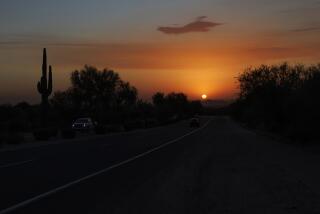Movement, Mostly in the Middle
LOS ANGELES — The next time you sit gridlocked in the Sepulveda Pass, gazing at five lanes of freeway choked to a stop by nothing except normal traffic, it may occur to you that the California myth is undergoing revision. And so it is. Many of the old dreams are dying, and the question is how we are dealing with it.
I’m not talking about politics, or whether our governments are going to “solve” the problems of the new, meaner version of California. I’m talking about individuals and what they are doing in response to the crush of civilization piling up on the Pacific slope.
Some answers to that question were supplied recently from an intriguing source. The state Department of Finance released its annual compilation of all the driver’s license address changes recorded in California during the prior year. These numbers show exactly where people are packing up to leave and where they are going. They show us the places where life has become most intolerable, and the places where people believe the dream still exists.
There is one caveat to keep in mind. The report reflects only licensed drivers, not the entire population, so it underestimates the total size of migrations. But the numbers are extraordinarily fresh, showing individual moves that took place as recently as this past June, and they reveal a state in the midst of a historic change.
The prime component of this change is a major exodus of the middle-class and the middle-aged from California’s large urban areas. By the tens of thousands, the over-30 crowd in Los Angeles, Oakland and San Jose is packing up and moving out.
Interestingly, most of these refugees are not fleeing to Arizona or Washington. Rather, they are staying inside the state borders, trying to re-discover the California they lost in the cities. The result is a flood of relatively affluent immigrants moving to San Luis Obispo, the Sierra foothills and the wine country north of San Francisco.
Virtually all the big population centers are contributing to this exodus, but Los Angeles County is the major supplier. Last year alone, it lost nearly 100,000 drivers to other counties, a rate of departure twice that of Orange County or Oakland’s Alameda County. The stream of migrants from Los Angeles is now feeding virtually every other part of the state from Ventura to Sonoma.
Meanwhile, outside California, the rest of the country has not caught on to the bad news about our urban life. Nearly matching the stream of middle-aged emigres leaving L.A. and the Bay Area is an incoming deluge of young people from other states. Most of the new arrivals are barely adults, 25 years old and younger.
Texas turns out to be our biggest admirer, sending more than 47,000 drivers westward. New York state sent 23,000. Even Washington state, which has whined for years about the alleged Californication of its turf, sent more drivers to California than vice versa. So shut up, Washington.
It’s hard to say where all this will leave California. Peter Morrison, a demographer at the RAND Corp., says the large influx of newcomers to the cities is a longtime trend, but the exodus of people in their 30s and 40s is not. Normally, urban migrants depart much earlier or much later in their lives.
Their withdrawal will leave the cities with ever-higher proportions of the very young, the poor and the wealthy. This process has been taking place for years and now it will accelerate.
On the receiving end of the migration, places like Placer County in the Gold Country will lose their rural character and come to resemble the homogenous suburbs of the 1950s, safe and sleepy regions where everyone is evenly aged and evenly financed.
You may like this picture of the future, you may not. Either way, it’s coming. And as it arrives in full force, you might consider one last irony: This whole migration is being financed, in large part, with the profits from real estate in the cities. The cities now being abandoned.
The small, life-of-Riley house in Van Nuys can now be sold for enough to allow the sellers to prowl through Placer County looking for a four-bedroom ranchette. It must seem like magic for those who do it.
You could, if you were an optimist, regard this exchange as a way of redistributing the wealth. Placer County gets part of what Los Angeles used to have. But I’m no optimist, and it seems to me that something else is happening. Those new ranchettes are really just a way of transferring Van Nuys to the Gold Country. If I were an oldtimer in Placer County, I think I’d rather stay poor.
More to Read
Sign up for Essential California
The most important California stories and recommendations in your inbox every morning.
You may occasionally receive promotional content from the Los Angeles Times.










